IDEX Online Research: Jewelry Price Inflation Remains High
September 29, 08
Both retail jewelers and jewelry suppliers raised prices significantly in August, according to the U.S. Bureau of Labor Statistics’ latest inflation data. This continues a trend which began early this year. It reflects rising commodity prices rather than a surge in final demand, which has been softer than normal in recent months.
Earlier this year, we said that we did not believe that price inflation could continue at these high single digit levels. For the year-to-date, retail jewelry prices are up 6.7 percent while jewelry producer prices are up 8.1 percent. We made our forecast based on declining precious metals prices late this summer; precious metals prices have been the primary driver of jewelry price inflation. However, with the recent volatility in the financial markets, some investors have moved into gold; this has driven up the price dramatically. Further, the U.S. dollar has lost traction. Thus, inflation appears to be ready to raise its ugly head, at least until the global financial system stabilizes.
Here’s the summary of inflation at the jewelry retail and supplier level for the month of August, as expressed as a percentage change year-over-year (August 2008 versus August 2007):
- Jewelry Producer Price Index +6.5 percent
- Jewelry & Watch Consumer Price Index +9.0 percent
- Jewelry CPI +10.3 percent
- Watch CPI +0.2 percent
Despite continued jewelry price inflation in August, we believe that we may have seen the largest price increases of the year during the first half of 2008, though there could continue to be cost pressures that will flow through to both suppliers and retailers in the coming months. At some point, the global financial system will stabilize, demand may pause, and inflation will return to more traditional levels.
While we suggest that jewelry price inflation may “moderate” for the balance of 2008, the term is relative. We continue to predict that jewelry prices at both the wholesale and retail level will rise by about 7 percent for all of 2008. That’s an inflation pace we haven’t seen since 1990.
Further, it is important to note that jewelry unit sales are down over 3 percent for the first eight months of 2008. This is the largest decline we’ve seen this decade. But it is no surprise: jewelry sales as measured by “dollars through the cash register” are up by only 3 percent or so, but jewelry price inflation has been high. The net result is that most jewelers will post modestly higher sales in 2008, but sell fewer items.
There are two key uncertainties. First, precious metals prices are no longer determined solely by supply and demand. Speculators in the financial markets add substantially to price volatility. If they believe, for example, that gold should be bought as a hedge against the falling U.S. dollar or the roiling financial markets, then gold prices will shoot straight upward again, as they did recently. And, second, precious and semi-precious gemstone prices are rising. Polished diamond prices have continued to rise at an accelerating rate, too. For example, the IDEX ONLINE Polished Diamond Price Index for all polished diamonds surged by nearly 15 percent in August 2008 versus the same month a year ago.
Jewelry Producer Price Index (JPPI) +6.5 percent in August
U.S. jewelry producer prices (JPPI) rose by 6.5 percent in August, 2008, according to the U.S. Bureau of Labor Statistics (BLS). This was the smallest monthly gain this year, and reflects retreating precious metals prices, a short-lived trend that occurred during the month.
There is still a backlog of costs in the distribution pipeline that suppliers will be passing on to their customers. Therefore, we don’t expect much moderation in inflation from current levels for the near term, based on higher costs which suppliers are incurring. The big question, though, is this: if demand softens significantly, will suppliers be forced to roll back prices? Or, with they simply hold prices at current levels, and let nature take its course? A price roll-back is unlikely, in our opinion, since suppliers’ margins are so slim. Thus, if anything, producer prices for jewelry may stabilize, but we do not look for any deflation.
The following graph summarizes the monthly Jewelry Producer Price Index for inflation since the beginning of 2007. The percentage figures are based on year-to-year comparisons of the BLS Jewelry Producer Price Index.
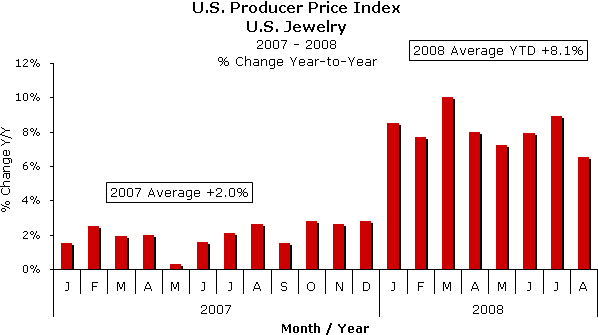
Source: BLS
What is fueling this accelerating rise in the Jewelry Producer Price Index? In prior months, it has largely been higher precious metals prices. However, in August, producer price inflation for precious metal jewelry moderated. Thus, we believe that higher gemstone prices – primarily a lag effect – have continued to push up jewelry prices.
The graph below compares the JPPI (red bars) to inflation for precious metals (gold bars); gold is the primary driver of precious metals inflation. We note, however, that producer price inflation in August was below the retail price inflation rate for the entire jewelry category. Earlier this year, producer prices in the precious metals category rose more than the corresponding retail prices. Now, retail prices are rising faster than producer prices in the precious metals category. Thus, the lag effect – 3-5 months – between rising producer prices and the resultant rising retail prices can be seen.
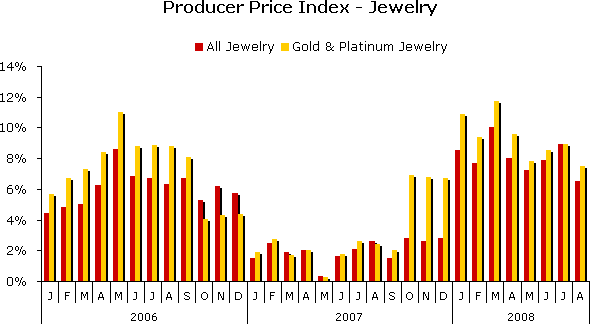
Source: BLS
Jewelry Consumer Price Index (JCPI) +9.0 percent in August
U.S. jewelry consumer prices (JCPI) rose by a sharp 9.0 percent in August, as calculated by the BLS. After rising sharply in March, April, and May, jewelry price increases at the retail level moderated in June, but have re-accelerated in July and August. For the year-to-date, retail price inflation for jewelry in the U.S. market is running at an annual rate of +6.7 percent.
We believe that jewelry retail prices rose sharply early in the year as retailers repriced goods to reflect the pent-up inflation that was flowing through from the supplier level. Zale, Sterling (Kay), and others announced they were going to raise prices. As a result most independent specialty jewelers also implemented price increases.
We think that June’s retail price inflation pause was either a statistical aberration or a momentary pause in inflation. Either way, jewelers have continued to raise their prices in the face of sharply rising costs, as shown by the July and August data.
The graph below summarizes the percentage change in retail prices of jewelry and watches by month on a year-to-year basis since 2007. The percentage change is based on a comparison to the same month a year ago (August 2008 versus August 2007).
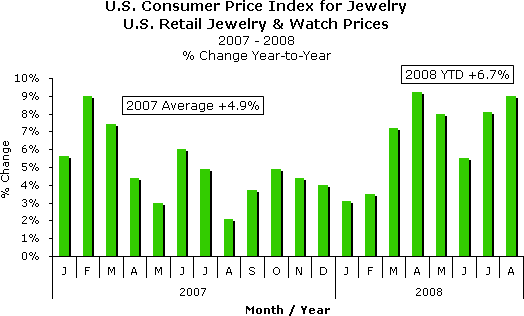 Source: BLS |
The components of jewelry and watch price inflation at the retail level reflect a dichotomy in price increases. Jewelry retail prices have been up consistently during the first half of 2008, but watch retail prices have shown virtually no price inflation this year, though they have risen almost imperceptibly in the past couple of months. We are a bit surprised that watch price inflation has lagged. Why? There are two key reasons: 1) mechanical watch mechanisms from Switzerland have been in short supply due to manufacturing capacity constraints; and 2) demand for high-end watches and branded watches has been strong, according to retail jewelers. However, because of the consistency of the BLS inflation numbers, we are inclined to believe that watch prices were down very slightly at retail, at least during the first half of the year.
The graph below illustrates the JPPI consisting of both jewelry and watch prices (green bars), jewelry prices only (red bars), and watch prices (yellow bars).
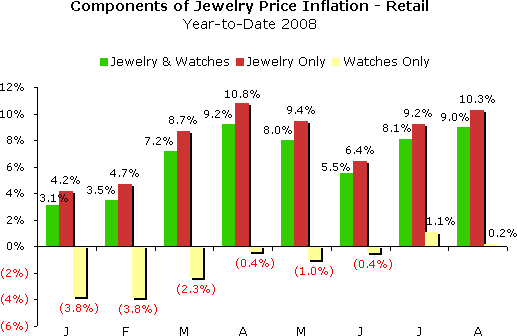
Source: BLS
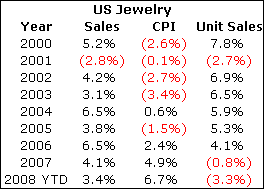 Source: BLS & IDEX Online |
Most U.S. jewelers can expect to sell fewer items this year, but they are likely to see more dollars flow through their cash tills. So far this year, jewelry sales are ahead by about 3.4 percent. However, year-to-date jewelry price inflation is running at 6.7 percent, a rate that is currently accelerating. Thus, unit sales are down by 3.3 percent.
The table on the left summarizes jewelry sales, the JCPI, and unit sales of jewelry since the year 2000. Unit sales are down by a greater level in 2008 than at any time in this decade.
Outlook: Above-Average Price Inflation Expected to Continue
Our forecast calls for both jewelry consumer prices and jewelry producer prices to rise by about 7 percent in 2008. We’re going to stay with those forecasts, despite some recent volatility in the data from the BLS.